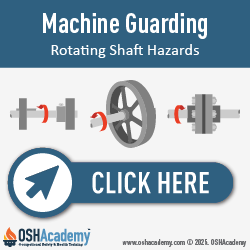Motions
Rotation
Rotation refers to the circular motion of machine components around a central axis or point, which can pose significant hazards in industrial settings.
Lathe Accident
Rotating parts, such as those described below, can entangle clothing, hair, or body parts, pulling them into dangerous areas of machinery. This motion is particularly hazardous because it can exert strong forces, leading to severe injuries like entanglement, crushing, or amputation. Even seemingly innocuous smooth surfaces can be dangerous due to their speed and momentum, and the risk is amplified by any projections on the rotating parts. Examples of rotating parts include the following:
- Rotating collars, couplings, cams, clutches, flywheels, shaft ends, and spindles: These components are commonly found in machinery like lathes, motors, or pumps. For example, a rotating collar on a shaft can catch loose clothing, such as a sleeve or glove, and rapidly pull the worker’s hand or arm into the machine. Similarly, flywheels, which store rotational energy, can create a continuous hazard due to their high-speed rotation, even when the machine appears idle. Spindles, often used in machining or textile equipment, can snag materials or body parts, leading to entanglement or severe injury.
- Projections such as screws or burrs: Projections like screws, keyways, or burrs on rotating parts significantly increase the hazard potential. These irregularities can act like hooks, catching onto clothing, tools, or body parts. For example, a burr on a rotating shaft can snag a worker’s glove, pulling their hand into a tight gap or against another component, resulting in crushing or shearing injuries. Regular maintenance to remove burrs and secure loose screws is critical to reducing these risks.
Rotating Shafts
Warning: Exposure to rotating shafts is the most dangerous machine safeguarding hazard.
Rotating shafts, such as those described below, pose extreme risks due to their high speed and torque. Workers can be entangled, pulled into the machine, or struck by projections (e.g., bolts, keys, or set screws) on the shaft, often resulting in fatal injuries. The danger is heightened when rotating parts have exposed projections or when workers wear loose clothing or jewelry that can get caught.
Examples of rotating shafts include the following:
- Motor Shafts in Industrial Equipment: Electric motors with exposed rotating shafts, common in manufacturing plants, can entangle a worker’s clothing or hair if they get too close. For example, a maintenance worker inspecting a motor without proper lockout/tagout may have their sleeve caught, pulling their arm into the shaft and causing severe trauma or amputation.
- Lathe Spindles: In machining, lathes use rotating spindles to hold and turn workpieces. If a worker’s glove or tool gets caught on a protruding set screw or key, they can be pulled into the machine, leading to catastrophic injuries. A documented case involved a machinist whose loose clothing was entangled in a lathe, resulting in a fatal accident.
- Drill Press Shafts: Drill presses have rotating spindles that can catch long hair, jewelry, or loose clothing. If a worker leans too close while operating the drill, they risk entanglement, which can scalp or severely injure them. An example is a worker whose necklace was caught in a drill press, causing neck injuries before the machine was stopped.
- Power Take-Off (PTO) Shafts in Agricultural Machinery: PTO shafts, used in tractors and farm equipment, rotate at high speeds to transfer power. If a farmer’s clothing or body part contacts an unguarded PTO shaft with protruding bolts, they can be entangled and pulled into the machinery, often resulting in death. A common incident involves a farmer caught in a PTO shaft while adjusting equipment, leading to fatal injuries.
To prevent accidents, rotating shafts must be fully guarded with fixed or interlocked covers to prevent access during operation. Workers should avoid loose clothing, tie back long hair, and remove jewelry. Lockout/tagout procedures are critical during maintenance, and regular inspections should ensure that projections like set screws are covered or recessed to minimize entanglement risks.
By understanding the specific hazards of reciprocating motions, transverse motions, and rotating shafts, and implementing robust safety protocols, workplaces can significantly reduce the risk of injuries and fatalities associated with these dangerous machine motions.
Knowledge Check Choose the best answer for the question.
1-3. What makes rotating parts especially hazardous in industrial settings?
You forgot to answer the question!

